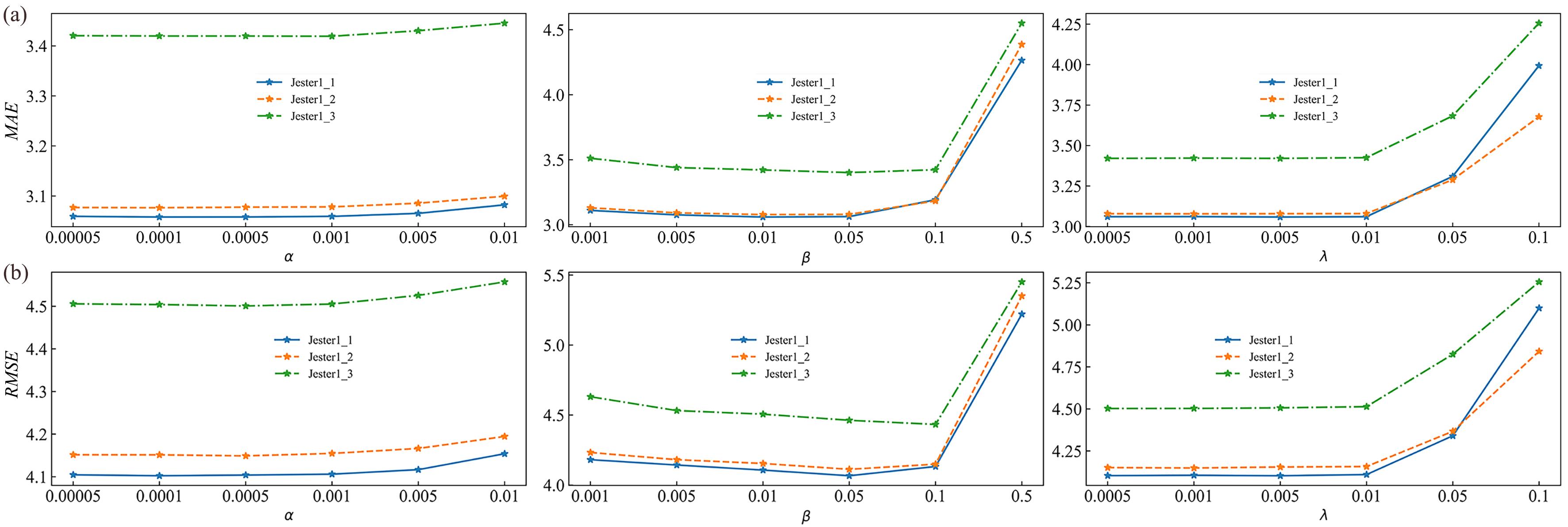南京大学学报(自然科学版) ›› 2022, Vol. 58 ›› Issue (1): 135–142.doi: 10.13232/j.cnki.jnju.2022.01.013
• • 上一篇
一种可解释性泛化矩阵分解推荐算法
- 西南石油大学计算机科学学院,成都,610500
An explainable generalized matrix factorization recommendation algorithm
Lü Yalan, Yuanyuan Xu, Hengru Zhang( )
)
- School of Computer Science,Southwest Petroleum University,Chengdu,610500,China
摘要:
可解释性矩阵分解解决了概率矩阵分解缺乏可解释性的问题,然而概率矩阵分解假设评分数据是服从正态分布的,这与实际场景有一定的偏差.针对该问题,提出一种可解释性泛化矩阵分解推荐算法.首先采用一种新型的变换函数使原始评分近似服从正态分布,然后通过可解释性矩阵分解获得预测评分,最后利用对应的逆变换函数将预测评分映射回原始评分区间.在三个数据集上进行实验,结果表明,与多个主流矩阵分解算法相比,提出的算法在多个评价指标上占优.
中图分类号:
- TP181
| 1 | Salakhutdinov R,Mnih A. Probabilistic matrix factorization∥Proceedings of the 20th International Conference on Neural Information Processing Systems. Vancouver,Canada:Curran Associates Inc.,2007:1257-1264. |
| 2 | 陈珂锐,孟小峰. 机器学习的可解释性. 计算机研究与发展,2020,57(9):1971-1986. |
| Chen K R,Meng X F. Interpretation and understanding in machine learning. Journal of Computer Research and Development,2020,57(9):1971-1986. | |
| 3 | 袁晓峰,钱苏斌,周彩根. 基于填充先验约束的矩阵分解算法. 南京大学学报(自然科学),2021,57(2):197-207. |
| Yuan X F,Qian S B,Zhou C G. Imputed prior constraint?based matrix factorization. Journal of Nanjing University (Natural Science),2021,57(2):197-207. | |
| 4 | Pujahari A,Sisodia D S. Pair?wise preference relation based probabilistic matrix factorization for collaborative filtering in recommender system. Knowledge?Based Systems,2020,196:105798. |
| 5 | Abdollahi B,Nasraoui O. Explainable matrix factorization for collaborative filtering∥Proceedings of the 25th International Conference Companion on World Wide Web. Montréal,Canada:International World Wide Web Conferences Steering Committee,2016:5-6. |
| 6 | Abdollahi B,Nasraoui O. Using explainability for constrained matrix factorization∥Proceedings of the 11th ACM Conference on Recommender Systems. Como,Italy:ACM,2017:79-83. |
| 7 | Fu Z L,Min F,Zhang H R. Recommendation with generalized logistic transformation∥Proceedings of 2018 IEEE International Conference on Big Knowledge. Singapore,Singapore:IEEE,2018:390-399. |
| 8 | Xue H J,Dai X Y,Zhang J B,et al. Deep matrix factorization models for recommender systems∥Proceedings of the 26th International Joint Conference on Artificial Intelligence. Melbourne,Australia:Morgan Kaufmann,2017:3203-3209. |
| 9 | Goldberg K,Roeder T,Gupta D,et al. Eigentaste:A constant time collaborative filtering algorithm. Information Retrieval,2001,4(2):133-151. |
| 10 | Zhang S,Liu L X,Chen Z L,et al. Probabilistic matrix factorization with personalized differential privacy. Knowledge?Based Systems,2019(183):104864. |
| 11 | Chen C H,Song F Y,Hwang F J,et al. A probability density function generator based on neural networks. Physica A:Statistical Mechanics and Its Applications,2020(541):123344. |
| 12 | Scott J G,Berger J O. Bayes and empirical?Bayes multiplicity adjustment in the variable?selection problem. The Annals of Statistics,2010,38(5):2587-2619. |
| 13 | Yang F,Liu N H,Wang S H,et al. Towards interpretation of recommender systems with sorted explanation paths∥Proceedings of 2018 IEEE International Conference on Data Mining. Singapore,Singapore:IEEE,2018:667-676. |
| 14 | D’Angelo G,Palmieri F,Rampone S. Detecting unfair recommendations in trust?based pervasive environments. Information Sciences,2019(486):31-51. |
| 15 | Rutkowski T,?apa T,Nielek R. On explainable fuzzy recommenders and their performance evaluation. International Journal of Applied Mathematics and Computer Science,2019,29(3):595-610. |
| 16 | Sato M,Ahsan B,Nagatani K,et al. Explaining recommendations using contexts∥Proceedings of the 23rd International Conference on Intelligent User Interfaces. Tokyo,Japan:ACM,2018:659-664. |
| 17 | Davtalab M,Alesheikh A A. A POI recommendation approach integrating social spatio?temporal information into probabilistic matrix factorization. Knowledge and Information Systems,2021,63(1):65-85. |
| 18 | Coba L,Symeonidis P,Zanker M. Personalised novel and explainable matrix factorisation. Data & Knowledge Engineering,2019,122:142-158. |
| 19 | Jiang G X,Wang W J. Markov cross?validation for time series model evaluations. Information Sciences,2017(375):219-233. |
| 20 | George G,Lal A M. Review of ontology?based recommender systems in e?learning. Computers & Education,2019(142):103642. |
| 21 | Li Z C,Tang J H,He X F. Robust structured nonnegative matrix factorization for image representation. IEEE Transactions on Neural Networks and Learning Systems,2018,29(5):1947-1960. |
| 22 | 周志华. 机器学习. 北京:清华大学出版社,2016,30-33. |
| 23 | Berger A,Guda S. Threshold optimization for F measure of macro?averaged precision and recall. Pattern Recognition,2020(102):107250. |
| 24 | Liu H S,Ren G F,Chen H Y,et al. Predicting lncRNA–miRNA interactions based on logistic matrix factorization with neighborhood regularized. Knowledge?Based Systems,2020(191):105261. |
| [1] | 郝昱猛, 马文明, 王冰. 基于特定用户约束的概率矩阵分解算法[J]. 南京大学学报(自然科学版), 2021, 57(5): 818-827. |
| [2] | 袁晓峰, 钱苏斌, 周彩根. 基于填充先验约束的矩阵分解算法[J]. 南京大学学报(自然科学版), 2021, 57(2): 197-207. |
| [3] | 徐媛媛,张恒汝,闵帆,黄雨婷. 三支交互推荐[J]. 南京大学学报(自然科学版), 2019, 55(6): 973-983. |
| [4] | 何轶凡, 邹海涛, 于化龙. 基于动态加权Bagging矩阵分解的推荐系统模型[J]. 南京大学学报(自然科学版), 2019, 55(4): 644-650. |
| [5] | 张燕平1,2张顺1,2钱付兰1,2严远亭1,2. 一种局部和全局用户影响力相结合的社交推荐算法[J]. 南京大学学报(自然科学版), 2015, 51(4): 858-865. |
| [6] | 韦素云1**,业宁1,吉根林2,张丹丹1,殷晓飞1 . 基于项目类别和兴趣度的协同过滤推荐算法*[J]. 南京大学学报(自然科学版), 2013, 49(2): 142-149. |
|
||






